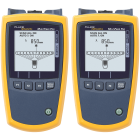如何通过环型通量提高多模测试准确性
March 11, 2013 / General
测试过多模光纤链路的人都应该了解,如果使用不同设备供应商提供的不同光源,最终得到的损耗值的浮动性高达50%。若未进行适当控制,则多模光源会以不同的方式将光注入多模光纤。 即使采用同一制造商生产的光源,但在不同的发射条件下也会产生不同的链路损耗测量结果,最终出现不同的 — 并且通常令人困惑的 — 测试结果。
不同类型的光源会有不同的发射条件。例如:发光二极管 (LED) 会使多模光纤过多填充模式组,而激光又未使光纤填充足够的模式组。Overfilling tends to produce link-loss measurements that are inappropriately high and under filling tends to generate loss measurements that are optimistic in regards to the loss that will occur in the cabling once it is operational.
这些有缺陷的结果最终会影响布线基础设施的性能,并且会造成数据中心和其它依靠光纤布线连接组件的环境方面的严重问题。
当考虑到网络技术已经进步并且损耗预算已经减少时,这就有些雪上加霜了。 为了满足紧缩的损耗预算,必须最大限度地减少测试不确定性。 因此,新型高性能宽带业务应用程序就成了现场测试仪器进行更准确和可重复进行多模衰减测量所需的动力。
行业专家认为有必要减小发射条件偏差,这在测试 1 GB 或更高多模光纤时显得尤为必要。
那么,解决方案是什么呢?答案是利用一种称为环形通量 (EF) 的标准,这是一种对以往方法所作的重大改进。环形通量 (EF) 是一种分析多模光源(例如: LED 或激光)启动条件的方法。它是在光源将光照射入多模光纤时光纤芯径内的功率百分比,并且它是通过近场测量来自连接测试仪器的参考等级测试线端的光确定的。
EF 标准可以将损耗测量的偏差减少至 +/- 10%。与以前允许高达40% 偏差的标准相比,EF 标准在多模测试的准确性和可重复性方面有了大幅改善。 因此,需要进行线缆认证以及批准布线保证的相关组织和人员已经开始要求遵守这一新标准。
目前有可用于现场测试的环形通量 (EF) 解决方案。它们被称作“发射控制器”,是与模式调节器一起安装的特制测试级参考线。发射控制器的工作原理是在 EF 技术指标范围内限制测试线发射的模式组数量。这样可确保根据标准,结果测量是精确且可重复的。
是否达到环形通量 (EF) 标准由测试仪器供应商确认,它们使用专门的实验室设备对多模光纤内包含的不同模式之间的功率分布直接进行测量。
测量包括使用视频和处理方法,分析测试线端的近场分布。图像会转变为数据和图解说明。可以在选定的 EF 限值范围内绘图,以检查其是否合规。
The Telecommunications Industry Association (TIA) and International Electrotechnical Commission (IEC) standards bodies both have documents that describe the requirements for EF.
EF 在将多模链路损耗测量缩小至 10% 偏差目标方面是一个重大进步。它将改善诸如模态功率分布和耦合功率之类的旧方法。由于符合 EF 标准的测试仪器会为认证测试提供最可靠的结果,因此网络工程师和设计师需要更新他们的测试技术指标,以要求使用符合 EF 标准的光源。






